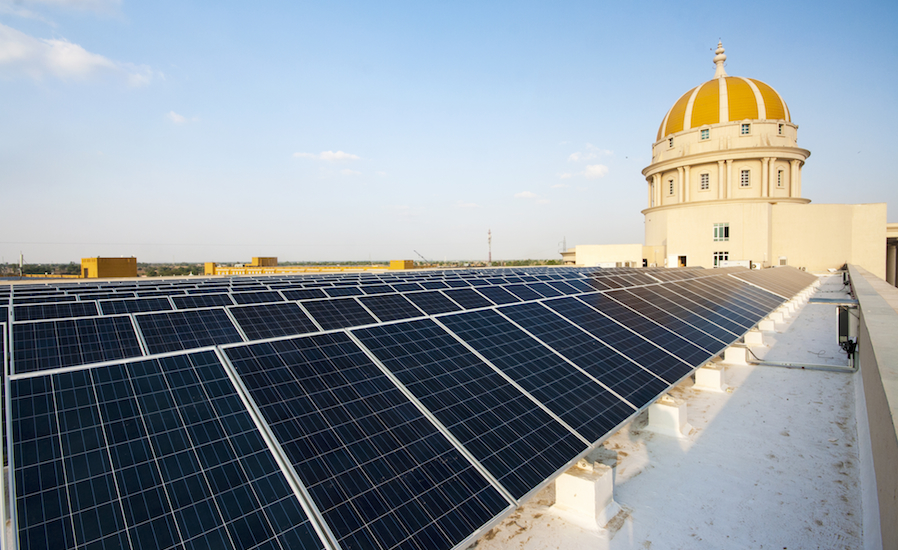When India announced at the Paris conference on climate change in December that it will install 100 GW of solar power by 2022, energy experts took it with a pinch of salt.
Citing hurdles such as poor transmission infrastructure and lack of access to finance, the skeptics thought it was a tall order for a country that has a total installed capacity of 5.8 GW and which still has rural areas that lack daylong electricity of any kind.
To meet the target, India needed to ramp up capacity additions from the past two year’s average of 4 GW to 15-plus GW per year. “There are many challenges, but we are working hard to achieve the target,” says Upendra Tripathy, secretary of the federal ministry for new and renewable energy.
Recent developments—and some luck—have given India a strong start. Falling costs have helped to put solar panels on the rooftops of businesses, residences and other buildings.
More panels soon will be installed. The Indian federal government recently approved a proposal to increase the subsidy for rooftop solar-power systems, to $770 million by 2022 from the current $92 million. Further, it has put in place a centralized facility that will enable consumers to apply online for installation of solar rooftops on their premises.
Overall, an impressive amount of electric-generating capacity recently has been completed. Tata Solar Power has installed a 12-MW rooftop solar plant in the northern state of Punjab. CEO Ashish Khanna calls it “the world’s largest setup in single phase.” Another 750-MW plant, Asia’s largest, is coming up in the state of Madhya Pradesh.
By May 2016, 7.5 GW of solar plants had been installed, 22 GW were under construction and another 9 GW were in requests for proposals. The government has announced 25 large-scale solar-power projects, with capacities ranging from 500 MW to 1,000 MW over a period of five years.
The national government has revised yearly targets for new capacity, and the new capacity will “bring us closer to our commitment to provide 24-hour electricity to all by 2019,” points out Piyush Goyal, India’s minister of state for power, coal, and new and renewable energy. He claims that, given adequate international financial and technological support, India could achieve its 2022 target earlier.
Experts doubt whether India can meet the ambitious targets on its own. At present, the country can produce only 1.2 GW of solar cells and 5.6 GW of solar panels a year. Most of the materials are imported because the domestic industry either is not cost-competitive or does not produce them.
This set of deficiencies has put a question mark over the government’s so-called domestic content requirement (DCR), under which both cells and modules must be manufactured in India. The U.S. has challenged the DCR through the World Trade Organization, which has called it illegal. India has appealed the verdict and continues to allocate projects under DCR.
Solar Power as Political Tool
Prime Minister Narendra Modi was elected in 2014 on a development agenda. He can use clean energy to push his development agenda further if he runs for reelection in 2019.
Rapidly falling sustainable-energy costs and COP21's greater environmental agenda are providing a welcome tailwind.
India needs $100 billion to achieve its target. Getting investors to believe in the viability of solar power was initially a big challenge for the country, but that’s changing. For example, access to finance is slowly opening up.
India has received low-cost funding worth $2.5 billion from the World Bank and other international development banks. “A combination of investments in India would be our largest financing on solar power for any country in the world,” says World Bank's President Jim Yong Kim.
During his recent U.S. visit, Modi finalized a $1-billion partnership with the U.S.-India Clean Energy Finance Task Force and the U.S.-India Catalytic Solar Finance Program. German development bank KFW has offered India low-interest loans of around $1.5 billion over the next five years.
Solar parks (20 GW) and rooftop projects (40 GW) form the major components of India’s solar ambitions. In 21 states, the federal government is setting up solar parks that have a cumulative capacity of nearly 20 GW under phase one. Further, india has announced a plan to add another 20 GW of capacity under phase two.
Shift in Emphasis to Residential Roofs
India’s solar market has grown exponentially in the past five years. Till now, it mostly was driven by large ground-mounted, grid-connected plants. There was simply not enough incentive for consumers to shift to solar. After rapidly bringing down solar tariffs, the government now wants to accelerate rooftop solar systems.
Over the past two years, the rooftop solar market in India has grown at a compound annual rate of 90%. The commercial-and-industrial segment makes up almost 73% of the market, leaving the remaining 27% for the residential segment.
India plans to install install on government buildings rooftop solar plants with a total capacity of 8 GW. State governments are following suit.
However, rooftop projects are now less dependent on government support than utility-scale projects. The fundamental economics are stronger, with minimal losses, avoidance of grid charges, and the ability to compete against retail, instead of wholesale, power prices. As viability improves, experts expect the industrial rooftop segment to account for the fastest expansion and predict an annual growth rate of 248% until 2020.
“We have seen our business double or triple in the past few years, and we believe this is only the tip of the iceberg,” says Andrew Hines, South India business development head at Mumbai-based CleanMax Solar.
“Contrary to some commentators, I see India’s goal of 40 GW of rooftop solar as eminently achievable, although it will take a concerted effort from the government, regulators and industries to achieve it in the timeline envisioned,” observes Hines.
“Rooftop solar systems make sense because they are distributed by nature,” argues Sowbhagya Rao, senior project fellow and manager of outreach and communication for solar at the Gujarat Energy Research and Management Institute. “They do not require expensive land. The effect of geographically distributing the systems helps to minimize variations. Moreover, the deployment of rooftop solar systems creates jobs.”




Post a comment to this article
Report Abusive Comment